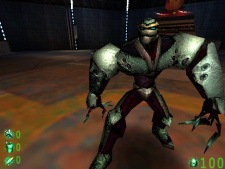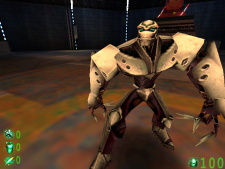 |
|
|
|
In the Forums... |
Posted: September 15, 1999 Written by: David "Spunk" Grampa Estimated retail price: $199.99 Two Heads are Better than One (DualHead Technology) Throughout the history of personal computers, many have craved that second monitor. Why? To get that tech-junkie steakout NSA feel, why else? And I'm not talking two displays with the same stuff appearing. I mean DVD movie here, writing G400 Review for Tweak3D there. I know this sounds silly, but I guess the second monitor is more of a 'cool' thing than a useful tool. Until now at the least, in the coming paragraphs I'll explain why. To get you familiar with the technology, the G400 gives you the ability to hook up your graphics card to two separate monitors. In layman's terms, you sees shtuff on two non-connected TV-like things. How did they pull it off? Easily. Using two CRT Controllers, and two dedicated 128-bit busses, the G400 is able to access the frame buffer from two separate 'places', and send the information to two different displays. Video card shotgunning if you will (no pun to DiamondMM intended =). You may think that duping your display is pointless, but that isn't where the options end. If you recall, Windows 98 offers support for multiple monitors. By integrating such available features into the G400's PowerDesk controls, Matrox was able to make many things possible. To list a few, you can extend your desktop onto the second monitor, or display something on one screen and enlarge an area of it on the other. Finally, you can watch a DVD movie on one screen while browsing Tweak3D on the other. The possibilities are close to endless. So what does all this mojonation have to do with games? Although almost all games lack the support for two monitors as of now, the list is growing... Microsoft's Combat Flight Simulator has broken the ice by being fairly optimized with multi-monitor support. Although we do not have shots available, it is possible to have the first person view (of being in the plane) on your primary screen, while displaing HUD information (such as maps) on the second display. There does happen to be a downside to all this DualHead glory. Besides not having widespread support to be optimized by games yet (see list), the system requirements are also rather high. A system running at 300MHz or higher is required while a 500MHz processor is recommended. While many of you may sit back and say "Oh, definitely not a prob," others simply do not have the luxury of a system running at these speeds. This fact will not totally antagonize the DualHead Technology, but should be taken into consideration so that the less fortunate do not send me hate mail for not telling them. Here is the list of future games with DualHead support:
The second feature that is specific (so far) to the G400 is its use of Environment Mapped Bump Mapping (EMBM). While being implemented into DirectX 6, the G400 is the first chip to integrate the use of this technology into the hardware. After experiencing a game that correctly implicates EMBM, you will agree that developer's are correct in saying that this technology has the essence to dramatically change 3D gaming. The reason being is simple- things just seem plain without it! I can't explain EMBM anymore with words, so I guess I'll have to leave it to these screens.
| |||

